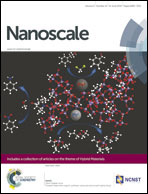Sub-diffraction positioning of a two-photon excited and optically trapped quantum dot†
Abstract
Colloidal quantum dots are luminescent long-lived probes that can be two-photon excited and manipulated by a single laser beam. Therefore, quantum dots can be used for simultaneous single molecule visualization and force manipulation using an infra-red laser. Here, we show that even a single optically trapped quantum dot, performing restricted Brownian motion within the focal volume, can be two-photon excited by the trapping laser beam and its luminescence can be detected by a camera. After two-photon excitation for a time long enough, the emitted light from the quantum dot is shown to blueshift. A quantum dot is much smaller than a diffraction limited laser focus and by mapping out the intensity of the focal volume and overlaying this with the positions visited by a quantum dot, a quantum dot is shown often to explore regions of the focal volume where the intensity is too low to render two-photon absorption likely. This is in accordance with the observation that a trapped quantum dot is only fluorescing 5–10 percent of the time. The results are important for realizing nano-scale quantum dot control and visualization and for correct interpretation of experiments using two-photon excited quantum dots as markers.


 Please wait while we load your content...
Please wait while we load your content...